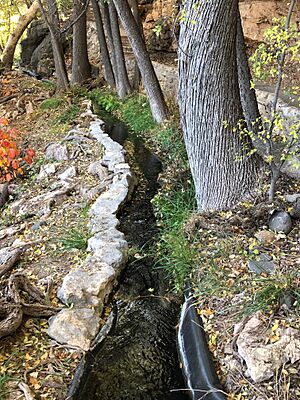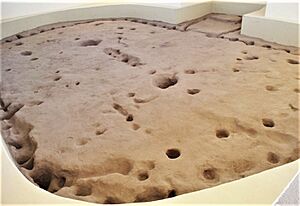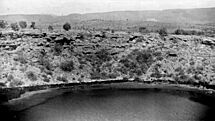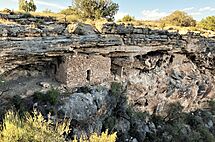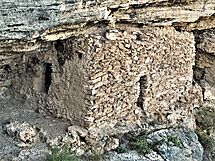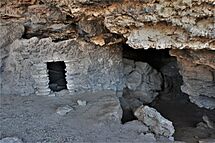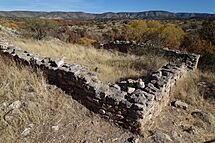Montezuma Well facts for kids
Montezuma Well (called Yavapai: ʼHakthkyayva by some native people) is a unique natural pool in Arizona. It's a part of the Montezuma Castle National Monument. This special place is a sinkhole where about 1.5 million gallons (5.7 million liters) of water flow out every day from an underground spring. It's located about 11 miles (18 km) northeast of Montezuma Castle.
The well is quite large, measuring about 386 feet (118 meters) across. It always has a lot of water, even when there's a drought. The water is very fizzy because it has a lot of carbon dioxide. It also contains high levels of arsenic. What makes Montezuma Well truly special is that it's home to at least five kinds of animals and plants found nowhere else on Earth. These include a tiny plant called a diatom, a special kind of snail, a water scorpion, a small amphipod, and a unique leech.
People have used the steady flow of water from Montezuma Well for irrigation since the 8th century. You can still see parts of an old irrigation ditch near the park's picnic area. Some parts of this ancient ditch are even used today!
Just like with Montezuma Castle, the name "Montezuma" is a bit misleading. The Aztec emperor Montezuma had no connection to this place or the early native people who lived here.
Contents
What is Montezuma Well?
Montezuma Well is like a giant hole in the ground that filled with water. It's similar to other sinkholes found in places like Florida and Mexico. Geologists believe it formed when a limestone cave collapsed, revealing the underground water source. The well sits on top of a very thick layer of limestone. This limestone formed between 8 and 2 million years ago from ancient shallow lakes that once covered Arizona's central Verde Valley area.
History of Montezuma Well
Scientists believe that people have lived in the Verde Valley for at least 10,000 years. However, the first signs of permanent homes in this area appeared much later, around 600 CE.
Ancient Homes and Farmers
You can find the remains of several ancient homes around the edge of Montezuma Well. The people who lived here belonged to different native American cultures. They are thought to have lived in the Verde Valley between 700 and 1425 CE. The most well-known group was the Southern Sinagua people.
The oldest ruin at the park is a "pithouse," which is a home built partly underground. This pithouse dates back to about 1050 CE. More than 50 rooms or structures have been found within the park. Some of these were likely used for storing food or for religious ceremonies, not just for living.
Irrigation and Farming
The Sinagua people, and possibly even earlier cultures, were skilled farmers. They used the constant water flow from Montezuma Well to water their crops. Around 700 CE, they built a man-made canal to direct the water from the well into their fields. Parts of this ancient canal are still used today!
This prehistoric canal was nearly seven miles long. It likely fed into a network of smaller canals, watering as much as 60 acres of farmland. While some parts of the modern canal follow the original route, many sections have been changed over time. You can still see much of the abandoned original canal within the park. The warm water from the well contains a lot of lime. Over many centuries, this lime built up along the canal walls, hardening into a cement-like coating that preserved the canal's shape.
Modern Discovery
Most European Americans didn't know about Montezuma Well until a book called Handbook to Arizona was published in 1878. In 1968, Montezuma Well was the first federal park to have an underwater archaeological survey. This survey was led by archaeologist George R Fischer.
The Yavapai people consider Montezuma Well a very sacred place. They believe it is where their ancestors first came into the world.
Life in Montezuma Well
The water in Montezuma Well has a very high amount of dissolved carbon dioxide gas. This is more than 80 times the amount found in regular freshwater. This, along with the water's alkalinity, means that no fish can live in the well.
However, other types of water creatures have adapted to this unique environment. As mentioned before, at least five endemic species live only in Montezuma Well. These include a diatom (a type of algae), the Montezuma Well springsnail, a water scorpion, the Hyalella montezuma amphipod, and the Motobdella montezuma leech. Many different kinds of birds visit the well to eat these organisms and the plants that grow in the water.
In recent years, a plant called Illinois pondweed has started to grow a lot in the well. Park staff need to do weekly maintenance to keep the water flowing freely through the natural outlet and into the irrigation ditch.
Images for kids



